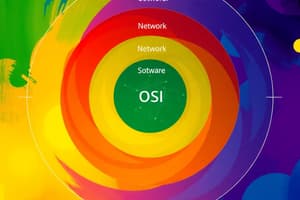Podcast
Questions and Answers
What is the Data-Link Layer responsible for?
What is the Data-Link Layer responsible for?
Ensuring reliable communication between devices on the same network.
Which of the following is NOT a primary function of the Data-Link Layer?
Which of the following is NOT a primary function of the Data-Link Layer?
- Routing (correct)
- Error Detection
- Framing
- Flow Control
The Data-Link Layer uses MAC addresses to identify devices on the network.
The Data-Link Layer uses MAC addresses to identify devices on the network.
True (A)
What does the MAC sublayer manage?
What does the MAC sublayer manage?
What is the purpose of error detection and correction in the Data-Link Layer?
What is the purpose of error detection and correction in the Data-Link Layer?
Match the following network topologies with their descriptions:
Match the following network topologies with their descriptions:
A MAC address is a _____ bit identifier used to distinguish devices on a local network.
A MAC address is a _____ bit identifier used to distinguish devices on a local network.
Flashcards
Data-Link Layer
Data-Link Layer
The second layer in the OSI model, ensuring reliable communication on the same network by organizing data into frames, managing MAC addressing, checking for errors, and controlling data flow.
Framing
Framing
Structuring raw bits into frames by adding headers and trailers for network transmission. This enables organized data transfer.
Addressing (MAC)
Addressing (MAC)
Using unique MAC addresses to identify source and destination devices on a local network, critical for directing data frames.
Error Detection and Correction
Error Detection and Correction
Signup and view all the flashcards
Flow Control
Flow Control
Signup and view all the flashcards
Media Access Control
Media Access Control
Signup and view all the flashcards
Logical Link Control (LLC)
Logical Link Control (LLC)
Signup and view all the flashcards
Study Notes
Overview of the Data-Link Layer
- Second layer in the OSI model, ensures reliable communication on the same network.
- Organizes data into frames, manages MAC addressing, checks for errors, and controls data flow.
- Sits between the Physical Layer (raw bit transmission) and the Network Layer (data routing).
Functions of the Data-Link Layer
- Framing: Structures raw bits into frames with added headers and trailers for network transmission.
- Addressing: Uses unique MAC addresses for identifying source and destination devices, with each NIC having a manufacturer-assigned MAC address.
- Error Detection and Correction: Employs techniques like cyclic redundancy checks (CRC) to detect errors; frames can be corrected or retransmitted upon error detection.
- Flow Control: Regulates data transmission rate to prevent sender from overwhelming the receiver, helping avoid data loss.
- Media Access Control: Manages shared access to the transmission medium using protocols like CSMA/CD for wired and CSMA/CA for wireless networks.
- Physical Addressing: Assigns physical addresses to devices for correct frame delivery within the same network segment.
- Error Reporting: Reports unacknowledged frame errors to higher layers for corrective measures.
Sublayers of the Data-Link Layer
-
Logical Link Control (LLC):
- Provides interface between the Network Layer and MAC sublayer.
- Manages error control, flow control, frame synchronization, and sequence numbers for data order.
-
Media Access Control (MAC):
- Controls device access to physical transmission medium.
- Handles MAC addressing and manages collision detection/avoidance.
MAC Addressing and Network Topologies
- MAC Addresses: 48-bit identifiers in hexadecimal format (e.g., 00:1A:2B:3C:4D:5E) for local network identification.
- Network Topologies:
- Bus Topology: All devices share a common line; devices listen before transmitting to prevent collisions.
- Star Topology: Devices connect to a central hub/switch that manages data transmission.
- Ring Topology: Devices connected in a circle; data passes from one device to the next until reaching its destination.
Studying That Suits You
Use AI to generate personalized quizzes and flashcards to suit your learning preferences.




